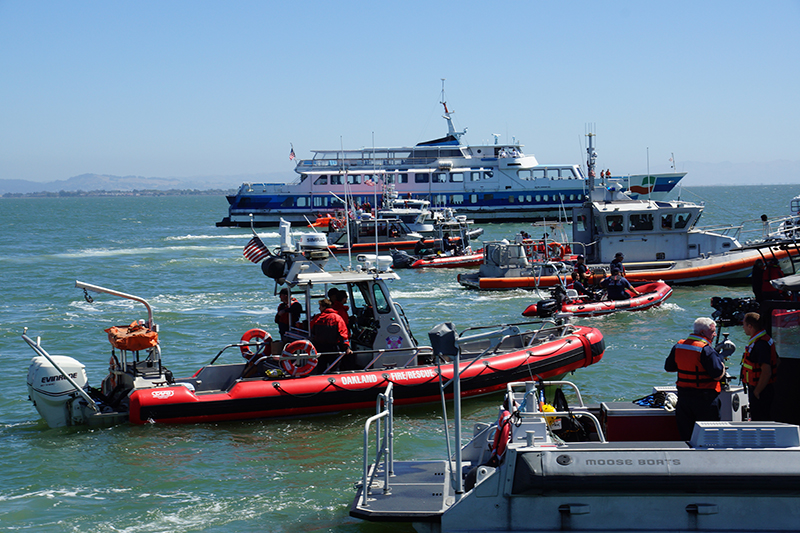Remembering Loma Prieta -- WETA's Role in Emergency Response

This interview appeared in the October 2020 issue of Full Speed Ahead, San Francisco Bay Ferry's monthly newsletter.
---
For this issue of Full Speed Ahead, we sit down with Keith Stahnke, operations and maintenance manager for the San Francisco Bay Area Water Emergency Transportation Authority (WETA). On October 17, 1989, Keith was a ferry captain for Blue & Gold Fleet. When the Loma Prieta earthquake struck, Keith and fellow captains jumped into action, shuttling stranded passengers from San Francisco back home to the East Bay after a section of the Bay Bridge collapsed and BART was closed. In this interview, Keith shares his memories from that day, including how Loma Prieta was a pivotal moment for ferry service in the Bay Area and how WETA is prepared today to respond to natural disasters and emergencies.
Interviewer: What is your role at WETA today?
Keith: I'm the operations and maintenance manager for WETA/San Francisco Bay Ferry. I oversee day-to-day operations, services, vessels, capital refurbishment projects, vessel construction, and facilities maintenance.
Interviewer: What were you doing when the Loma Prieta earthquake struck?
Keith: I was a ferry captain for Blue and Gold Fleet at the time. We were just off of Aquatic Park, nearing the end of a bay cruise. When the earthquake hit, we felt it on the water and it was really unusual. It felt like we were being lifted up and down three or four feet, not like the gentle rolling or pitching that you might normally experience on a boat. It was fairly short, but it was definitely noticeable on the water.
Interviewer: Did you think it was an earthquake? What did you think was happening?
Keith: At first, I thought that somebody was jumping up and down on the deck and then I started thinking of more unusual things, like maybe I caught a net around the propeller. Almost immediately after it stopped, I heard vessel traffic say over the radio, "There's just been a major earthquake". And I remember looking to the big buildings in San Francisco, wondering if they're going to fall over. Then I heard somebody say, "Oh, the Bay Bridge just fell down." And I was looking at the Bay Bridge when I heard that, thinking, “it didn't fall down,” but obviously that was when one section of roadway had collapsed.
Interviewer: What happened next?
Keith: When we got back to the dock, it was 5:30 or so and the management had gone home for the night. It was also the World Series, so everybody was watching the game. Nobody had cell phones back then and so it was really difficult to get a hold of anybody to figure out what we should do next.
Before this, we had few meetings with the city about earthquake response, but we didn’t have a coordinated plan. Right after the earthquake, I took the boat down to the Ferry Building and it was just a mass of people. I wasn’t sure where they were going – at first, I thought these might be Larkspur passengers waiting for Golden Gate Ferry. Over the PA, I asked people to raise their hands if they wanted to go to Oakland, and everybody rose their hand. So we loaded the boat to max capacity, 400 passengers, and took them to Oakland.
Interviewer: After that first trip to Oakland, did you come back to San Francisco and do another run? Were there more people waiting?
Keith: We did. While we were making that first trip, our other boats got organized and we had three more boats come to help. In total, I think there were five or six boat trips that carried at capacity and we were able to bring everybody over to the East Bay who had been waiting at the Ferry Building.
Interviewer: What stands out in your memory from that night?
Keith: One thing I remember was just how dark it was, because virtually all the lights in Oakland, Berkeley, Treasure Island and San Francisco were out and even the lights on the Bay Bridge were out. You could see the glow of the fire in the Marina and exploding transformers on the Berkeley and Oakland Hills. There was a strong smell of natural gas and sewage in the area because pipes underneath the piers that had broken.
Interviewer: Will you describe the days and weeks following Loma Prieta and what role ferries played?
Keith: After the earthquake struck, we quickly organized a pop-up ferry service to get all those people back to the East Bay. in the days following, there was an official ferry service to Oakland in place with multiple boats and expanded service to Vallejo which at the time was only one commute trip a day. That quickly grew to include to Berkeley, Richmond and Alameda. There was really good ridership for the first 30 days when the Bay Bridge was shut down.
Once the Bay Bridge reopened, ridership did drop off significantly. This interim ferry service carried on until January or February, but the legacy is that the Oakland and Alameda service never did shut down and continues to this day. That really was the impetus to start the planned regional ferry service that we have now.
Interviewer: What’s the difference between 1989 and now? Today, how is WETA prepared to respond to an emergency?
Keith: In 1989, there were 6 ferry boats operating on four routes in the bay area, now we have 24 ferries on 10 routes, plus the additional growth of private vessels. We have much greater capacity today. WETA participates in training and exercises with the State Office of Emergency Services, San Francisco Department of Emergency Management, and other response agencies. We also coordinate with the other transit agencies to plan and prepare. Now it's a regional coordinated effort of preparedness and planning and we're so much better prepared now to respond.

